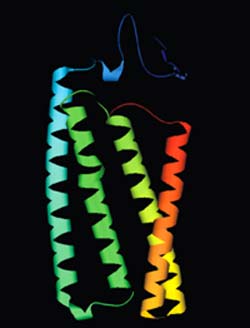Scientists model 900 cell receptors, drug targets

This GPCR’s specific function is still unknown. The database could help scientists determine the function of receptors like this one, potentially uncovering new drug targets.
Models could help speed discovery of new drugs
In an important step toward accelerating drug discovery, researchers have created computer models of more than 900 cell receptors from a class of proteins known to be important drug targets. The models, which are now freely available to noncommercial users, promise to help scientists narrow their research inquiries, potentially speeding up the discovery of new drug compounds. The research appears in the February 17, 2006 issue of the Public Library of Science Computational Biology.
“This is the first time anyone has modeled them all with an algorithm that improves the accuracy of the structure,” said Jeffrey Skolnick Georgia Research Alliance Eminent Scholar in Computational Systems Biology at the Georgia Institute of Technology. “I think it’s going to have significant impact, because it’s a major class of drug design.”
One of the hottest areas in drug research, rational drug design uses three-dimensional computer simulations to study how different drugs and their cellular targets interact with each other. This technique can help research teams discover which compounds are most likely to achieve the desired results, potentially accelerating the speed of drug research and allowing for the discovery of reactions that may not have been found through traditional means.
G protein-coupled receptors are targeted by an estimated one-third of all drugs and convey chemical signals from the outside of cells to the inside. But because they tend to fall apart once they’re removed from the outer membrane of the cell, scientists have only been able to solve the three-dimensional structure for a few of them. And those aren’t even good drug targets. Until now, researchers wanting to model any of the others have had to base their models on the structures of the existing, non-pharmacological receptors. Since those receptors, according to Skolnick, are evolutionarily distant from the proteins thought to be good drug targets, the models aren’t very accurate.
Using an algorithm they developed known as TASSER, a team of researchers led by Skolnick, then at the University of Buffalo, created three-dimensional structures of all the GPCRs below 500 amino acids in the human genome.
“The solved GPCRs are of the same approximate shape as the ones known to be good drug targets, only they differ in details. But it’s the details, the packing of the helixes, their angles, their size, that differentiate the drug binding sites of GPCRs from one another,” said Skolnick, “TASSER appears to have the capacity to give us a reasonable picture of the structure of these proteins.”
Of the 907 models TASSER has helped create, Skolnick estimates that about 820 are accurate enough to be useful to researchers.
“There’s still room for significant improvement. They’re like cartoons – they kind of look like reality sometimes, but they can be used to help design experiments,” said Skolnick.
The mission of the Center for the Study of Systems Biology at Georgia Tech, of which Skolnick is the director, is to essentially simulate life on a computer by building accurate three-dimensional models of the components of life, such as individual proteins and collections of proteins.
“The idea is to simulate these proteins, introduce a drug structure and see how they interact,” said Skolnick.
The next step for Skolnick is solving the structure of proteins that have been implicated as a factor in various types of cancer.
Media Contact
More Information:
http://www.gatech.eduAll latest news from the category: Life Sciences and Chemistry
Articles and reports from the Life Sciences and chemistry area deal with applied and basic research into modern biology, chemistry and human medicine.
Valuable information can be found on a range of life sciences fields including bacteriology, biochemistry, bionics, bioinformatics, biophysics, biotechnology, genetics, geobotany, human biology, marine biology, microbiology, molecular biology, cellular biology, zoology, bioinorganic chemistry, microchemistry and environmental chemistry.
Newest articles

Superradiant atoms could push the boundaries of how precisely time can be measured
Superradiant atoms can help us measure time more precisely than ever. In a new study, researchers from the University of Copenhagen present a new method for measuring the time interval,…

Ion thermoelectric conversion devices for near room temperature
The electrode sheet of the thermoelectric device consists of ionic hydrogel, which is sandwiched between the electrodes to form, and the Prussian blue on the electrode undergoes a redox reaction…

Zap Energy achieves 37-million-degree temperatures in a compact device
New publication reports record electron temperatures for a small-scale, sheared-flow-stabilized Z-pinch fusion device. In the nine decades since humans first produced fusion reactions, only a few fusion technologies have demonstrated…





















